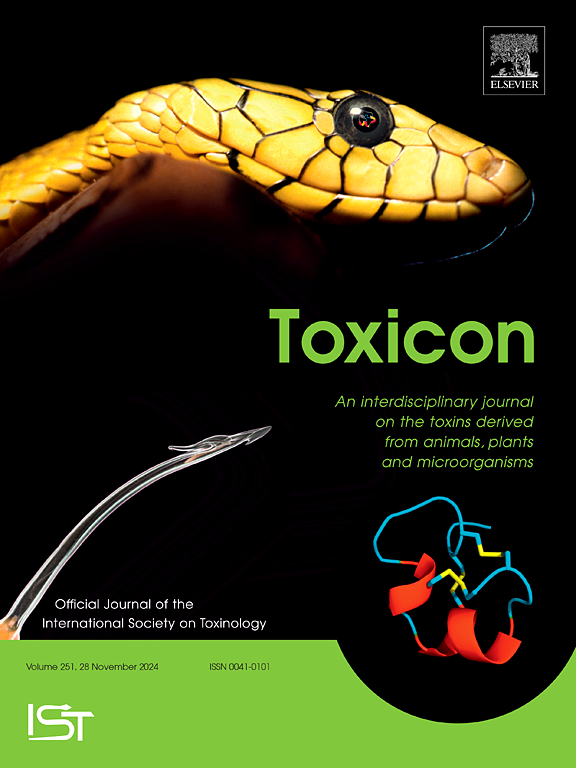黎巴嫩有毒植物及其影响概述。
IF 2.6
4区 医学
Q2 PHARMACOLOGY & PHARMACY
引用次数: 0
摘要
有毒植物自然存在于环境中,特别是儿童很容易接触到。这些植物带来的风险很大,从轻微或无症状到严重甚至危及生命。有关黎巴嫩有毒植物的数据既少又分散;因此,有关黎巴嫩有毒植物的文献仍然存在很大空白。本研究依赖于对有关黎巴嫩有毒植物及其影响的现有文献的彻底审查。根据我们在该领域的经验以及文献中的可用数据,我们编制了一份黎巴嫩重要的潜在有毒植物清单。黎巴嫩的有毒植物根据其化学特性分为生物碱;苷;蛋白质、肽和凝集素;酚和苯丙酮;萜烯和树脂;羧酸;以及其他(未分类)等类别。我们详细讨论了这些植物的临床效果,以概述它们可能造成的毒性。这项研究是我们正在进行的黎巴嫩有毒植物研究工作的一部分。它旨在填补有关有毒植物的空白;同时将使医护人员和公众受益。及时识别植物接触及其表现将有助于更好地进行临床治疗,尤其是对急诊医护人员和专业人员而言。此外,本综述还将提高黎巴嫩公众对黎巴嫩有毒植物的认识,最终目的是从一开始就预防这些有毒事件的发生。本文章由计算机程序翻译,如有差异,请以英文原文为准。

An overview of the poisonous plants of Lebanon and their effects
Poisonous plants are naturally found in the environment and are easily reachable especially by children. These plants pose significant risks ranging from mild or asymptomatic to severe and even life-threatening. Data on poisonous plants of Lebanon is scarce and scattered; therefore, there remains a significant gap in the literature concerning poisonous plants in Lebanon. This study relied on a thorough review of existing literature on poisonous plants of Lebanon and their effects. Based on our experience in the field and on leveraging available data from the literature, a list of important potentially toxic plants in Lebanon was compiled. Toxic plants in Lebanon were categorized based on their chemical properties into groups such as alkaloids; glycosides; proteins, peptides, and lectins; phenols and phenylpropanoids; terpenes and resins; carboxylic acids; and other (uncategorized). The clinical effects of these plants were discussed in detail to provide an overview of the toxicity that they can cause. This study is part of our ongoing work on poisonous plants of Lebanon. It aims to fill a gap pertaining to poisonous plant; it will benefit healthcare workers and the public at the same time. Prompt recognition of plant exposure and their manifestations will allow for better clinical management especially among emergency healthcare workers and professionals. In addition, this review will increase awareness of Lebanese public about the poisonous plants of Lebanon with the ultimate aim to prevent these toxic occurrences from the beginning.
求助全文
通过发布文献求助,成功后即可免费获取论文全文。
去求助
来源期刊

Toxicon
医学-毒理学
CiteScore
4.80
自引率
10.70%
发文量
358
审稿时长
68 days
期刊介绍:
Toxicon has an open access mirror Toxicon: X, sharing the same aims and scope, editorial team, submission system and rigorous peer review. An introductory offer Toxicon: X - full waiver of the Open Access fee.
Toxicon''s "aims and scope" are to publish:
-articles containing the results of original research on problems related to toxins derived from animals, plants and microorganisms
-papers on novel findings related to the chemical, pharmacological, toxicological, and immunological properties of natural toxins
-molecular biological studies of toxins and other genes from poisonous and venomous organisms that advance understanding of the role or function of toxins
-clinical observations on poisoning and envenoming where a new therapeutic principle has been proposed or a decidedly superior clinical result has been obtained.
-material on the use of toxins as tools in studying biological processes and material on subjects related to venom and antivenom problems.
-articles on the translational application of toxins, for example as drugs and insecticides
-epidemiological studies on envenoming or poisoning, so long as they highlight a previously unrecognised medical problem or provide insight into the prevention or medical treatment of envenoming or poisoning. Retrospective surveys of hospital records, especially those lacking species identification, will not be considered for publication. Properly designed prospective community-based surveys are strongly encouraged.
-articles describing well-known activities of venoms, such as antibacterial, anticancer, and analgesic activities of arachnid venoms, without any attempt to define the mechanism of action or purify the active component, will not be considered for publication in Toxicon.
-review articles on problems related to toxinology.
To encourage the exchange of ideas, sections of the journal may be devoted to Short Communications, Letters to the Editor and activities of the affiliated societies.
 求助内容:
求助内容: 应助结果提醒方式:
应助结果提醒方式:


